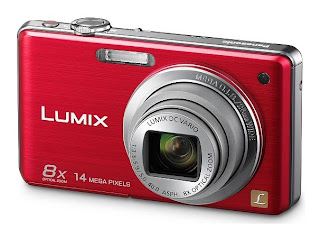Panasonic has equipped FH20 large optical zoom while maintaining his fragile body together with a range of features to automatically detect scene.
On the basic configuration, the DMC-FH20 also not bad compared to the competitor with resolution 14.1 million pixels, 8x optical zoom (28 - 224mm) lens with moderate wide-angle and mechanisms optical stabilization, 2.7 inch LCD 230,000 pixels and Macro shooting capability with a minimum 5cm.
Square design, classic, DMC-FH20 youthful looks and new technology style with four color choices. The front consists only of the lens, flash and focus assist lamp. Optical viewfinder has been removed, instead all operations will be done through LCD screen. With moderate quality, only 230,000 pixels as the vast majority of other travel machine, the DMC-FH20 enough to frame and review photos and video, rather than bringing a quality difference.
Besides the majority of LCD monitors in the back is the Edit button basic parameters are very familiar and easy to use, almost similar to the lifetime of the machine even if different vendors such as flash adjustment, adjustment mode, adjust exposure compensation, auto capture and switch screen. Mode button is designed to leave with the ability to convert normal video mode, the default scene, or custom video. Button gotten between shooting modes and playback are arranged as a switch, a little inconvenient, while the new generation often use electronic button for users who want to move fast on small mode just shutter instead of moving images such as the switch on this version.
On the above, the DMC-FH20 is also relatively simple design with power switch, camera button and zoom ring combination, it is next iA button allows fast transfer of the intelligent mode. This mode allows the user to select between six default mode as intelligent portrait (i-Portrait), landscape (i-Scenery), macro shot, taken at night (i-Night Portrait) ... very suitable for adjustment problems or those new to photography.
Panasonic's menu system is simple, relatively easy to understand and not take a long time familiar. Besides the traditional menu system, with Q. Menu button, users can quickly access to the basic parameters of the machine easily through the system of symbols, quite easily even with people who do not know much English.
Continuous shooting mode of FH20 basically achieved 1.5 frames per second, but in case of need speed, the shooting can lower the resolution down to 3 million pixels to achieve 4.6 frames per second. Especially with the default scene, the shooting can freely choose between the default 25 setting scenes, meet the most common situations, though sometimes also makes people more options the user should select wonder what mode is most appropriate.
Keeping up with the new generation this year, Panasonic has also equipped for video-recording capabilities FH20 HD 1280 x 720 pixels at 30 frames per second but still use the QuickTime format MPEG more compact instead of AVCHD. Although the video quality of HD but only average, but just enough resolution process serrated less. In addition, no optical zoom during filming and recording mono instead of stereo is also an inherent weakness of the tourism machine that FH20 is no exception. One other point that is a little inconvenient shooting mode button will not be separated as many different versions that must be accessed through the navigation menu makes somewhat more complicated.
The quality of outdoor photos FH20 nothing to complain. With enough light, bright colors show, details, contrast, keep the area reasonably bright and dark areas. Speed of operation is also found on average to focus only time 0.011 seconds, boot time is about 1.7 seconds.
In automatic mode, white balance, color FH20 warm bias, while if the manual switch back into cold air. Flash operation at the average from approximately 3 meters, but the light is pretty fast recovery time, only around 3 to 4 seconds.
Lens quality is excellent on FH20 not as expected. In the test images, sharpness achieved only in the central area, as the edge image sharpness falling. At telephoto focal length even at the center sharpness also started to recognize the decline. Image distortion is inevitable when fully extended lens size and only slightly lower at telephoto focal lengths. Interfering particles, although well-controlled but also from ISO 80 to 200, and 400 or more from the strip appeared much noise as reduced quality and loss of image details.
However, when considering the price of FH20, see the product line this valuable features such activity was quite reasonable. In terms of configuration, large optical zoom while maintaining his fragile body together with a range of features that automatically detect scene Panasonic equipment, FH20 can say is popular enough version suitable for the majority of users can access the technological advances of the digital photography without spending too much cost.







No comments:
Post a Comment